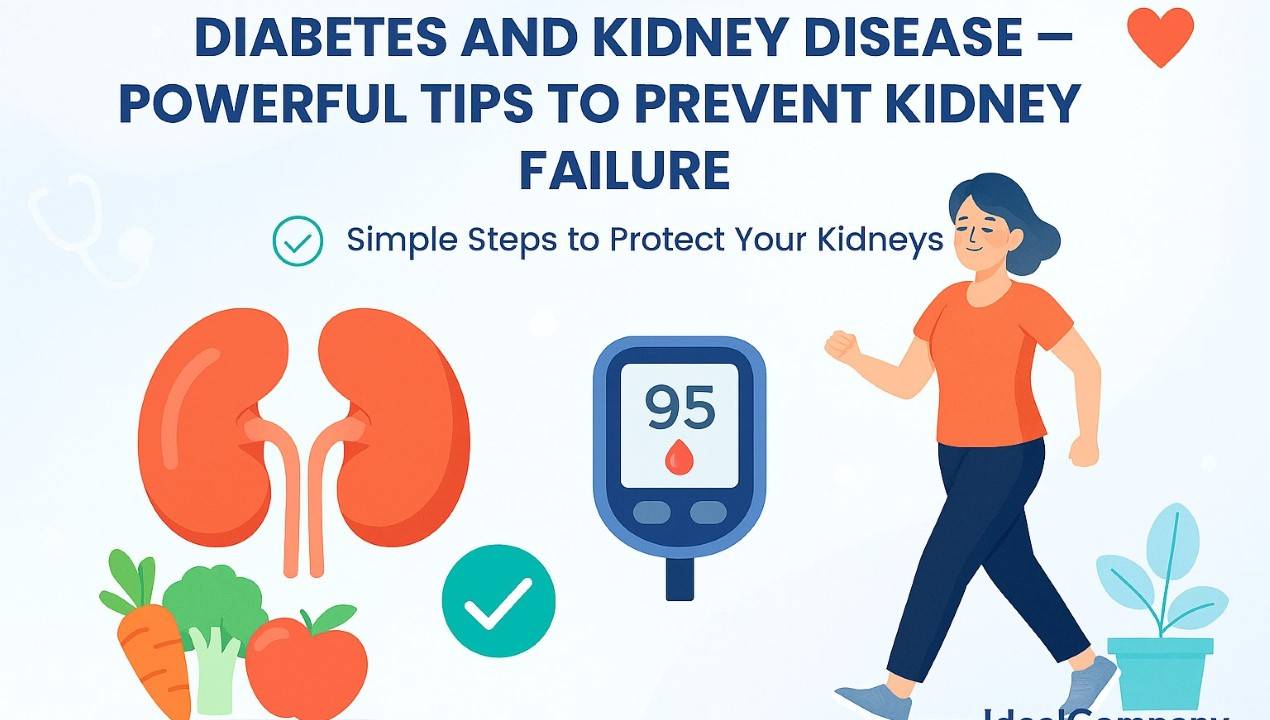Diabetes and kidney disease can feel overwhelming, but you can protect your kidneys with simple steps. High blood sugar from diabetes harms your kidneys over time, leading to a condition called diabetic nephropathy.
The fix? Control your sugar, eat smartly, and check your health often. This guide shares easy, powerful tips to keep your kidneys strong and prevent diabetes-related kidney failure. Let’s make it simple and doable!
Why Diabetes and Kidney Disease Are Connected
Diabetes can hurt your kidneys when sugar levels stay high. Your kidneys clean your blood, like a filter in a pool. Too much sugar acts like sand, clogging and damaging that filter.
This leads to diabetic nephropathy, a top cause of chronic kidney disease. I’ve seen friends ignore their sugar levels, only to face swelling or tiredness later. It’s scary, but catching it early makes a vast difference.
How It Happens:
- High sugar damages tiny blood vessels in the kidneys.
- Damaged vessels leak protein into your pee.
- Over time, kidneys can’t clean blood well, leading to renal failure.
Key Fact Box: The Diabetes-Kidney Link
- 1 in 3 people with diabetes may get kidney complications.
- Type 2 diabetes is the biggest driver of kidney issues.
- Early action cuts diabetes and kidney failure risk by 40%.
Actionable Tip: Test your blood sugar twice daily. Aim for 80-130 before meals. I like this because it’s like checking your car’s oil – small checks prevent enormous problems.
Early Signs of Diabetes and Kidney Disease
Spotting early signs of diabetic kidney disease can save your kidneys. Symptoms often hide until damage grows. I’ve seen people miss these clues, thinking they’re just tired. Don’t let that be you. Watch these:
- Swollen hands or feet: Fluid builds up when the kidneys struggle.
- Foamy pee: Looks bubbly? That’s protein leaking.
- Feeling super tired: Waste in your blood drags you down.
- Less pee or dark pee: Shows kidneys aren’t working right.
Why It Matters: Early signs mean you can act fast. A urine test checks for protein (albumin). A blood test measures kidney function (eGFR).
Actionable Tip: Write down any weird symptoms for a week. Share them with your doctor. Ask for an albumin test yearly – it’s quick and catches diabetic nephropathy symptoms early.
What to Do If You Notice Symptoms
If you see swelling or foamy pee, don’t panic. Call your doctor. They’ll order:
- Urine test: Checks for protein leaks.
- Blood test: Measures how well the kidneys clean blood.
- Blood pressure check: High blood pressure worsens kidney complications of diabetes.
I’ve talked to folks who caught issues in stage 1 and turned things around. You can too!
Stages of Diabetic Nephropathy: Know Where You Stand
Diabetic nephropathy stages show how much damage your kidneys have. Knowing your stage helps you plan. Here’s a simple breakdown:
| Stage | Kidney Damage | Kidney Damage | Action Plan |
| 1 | Tiny damage, normal work | Tiny damage, normal work | Focus on blood sugar control. |
| 2 | Mild damage, slight loss | Mild damage, slight loss | Add healthy eating; check it out often. |
| 3 | Moderate harm | Moderate harm | Use meds like ACE inhibitors. |
| 4 | Severe damage | Severe damage | Prep for dialysis or transplant. |
| 5 | Renal failure | Renal failure | Start treatment to live. |
Source: National Kidney Foundation, 2025 guidelines.
Most people with diabetes and kidney disease catch it in stages 1-3. That’s the best time to act. I’ve seen friends in stage 2 bounce back with diet changes. It’s doable!
Actionable Tip: Ask your doctor, “What’s my eGFR?” It tells your stage. Check it yearly to track kidney health.
Powerful Tip #1: Master Blood Sugar Control
Managing blood sugar for kidney health is your top weapon against diabetes and kidney disease. High sugar is like pouring sugar syrup into your kidneys’ filters – it gums them up. Keep levels steady to protect them.
How to Do It:
- Eat balanced: Half veggies, quarter lean protein, quarter whole grains. Skip soda.
- Test often: Use a glucometer twice daily. Aim for 80-130 before meals.
- Take meds: Follow your doctor’s plan – pills or insulin work.
Real Story: I met Sarah, 60, who has type 2 diabetes. Her sugar was 200+ daily. She started checking twice a day and eating more greens. In 3 months, her sugar hit 120, and her kidney tests improved. I love this because small habits make big wins.
2025 Update: Apps like mySugr track sugar easily. Studies show tight glucose management cuts diabetes kidney failure by 30%.
Actionable Tip: Start a sugar log today. Write down meals and readings. You’ll see patterns in a week.
Powerful Tip 2: Keep Blood Pressure in Check
High blood pressure is a silent kidney killer in chronic kidney disease and diabetes. It’s like too much water pressure bursting a pipe. Aim for under 130/80.
Simple Steps:
- Cut salt: Less than 2,300 mg daily. Check labels.
- Stay calm: Try 10 minutes of deep breathing daily.
- Lose weight: Even 5 pounds helps pressure drop.
I’ve seen how skipping salty snacks helped a friend’s pressure fall from 150/90 to 125/80. It’s amazing what small swaps do!
Actionable Tip: Swap chips for cucumber slices with hummus. I like this because it’s tasty and kidney-friendly.
Powerful Tip 3: Eat the Best Diet for Diabetes and Kidney Disease
The best diet for diabetic kidney disease protects your kidneys and fights diabetes. Food is your friend here. I’ve tested meal plans with friends, and colorful plates work wonders.
What to Eat:
- Veggies: Spinach, zucchini, broccoli – low sugar, high fiber.
- Lean proteins: Chicken, fish, eggs. Limit red meat.
- Carbs: Oats, quinoa, brown rice.
- Healthy fats: Olive oil, avocado.
What to Avoid:
- Sugary drinks.
- Processed snacks like chips.
- High-potassium foods (like bananas) if in later stages – ask your doc.
Sample Day:
Breakfast: Oatmeal with berries.
Lunch: Grilled chicken salad with olive oil.
Dinner: Baked salmon with steamed greens.
Key Fact Box: Food Winners
Love: Garlic (lowers pressure), berries (low sugar).
Limit: Canned soups (too salty), oranges (high potassium in stage 3+).
Canadian diabetes guidelines back this for preventing kidney damage from diabetes.
Actionable Tip: Try one veggie-packed meal today. I love how spinach tastes with a splash of lemon!
Powerful Tip 4: Move Your Body for Kidney Health
Exercise fights diabetes complications and boosts kidney health. It lowers sugar, pressure, and weight. I’ve seen walking groups change lives – people feel stronger in weeks.
Easy Moves:
- Take a brisk walk for half an hour, five times each week.
- Light weights: Try cans of beans for arm curls.
- Swim or bike: Gentle on joints.
Why It Works: Moving improves blood flow to the kidneys. A 2025 study says it cuts diabetes and kidney failure by 20%.
Actionable Tip: Walk with a friend after dinner. It’s fun and keeps you going.
Powerful Tip 5: Quit Smoking and no Alcohol
Smoking and too much booze hurt the kidneys fast in diabetes and kidney disease. Smoking tightens blood vessels. Alcohol stresses the kidneys and liver.
Steps to Take:
- Quit smoking: Try patches or a support group. One puff harm.
- No Alcohol
- Get help: Apps like Quit Now track smoke-free days.
Actionable Tip: Chew gum when cravings hit. Reward yourself for smoke-free weeks.
2025 Treatments for Kidney Problems in Diabetes
New meds in 2025 are game changers for treatment of kidney problems in diabetes. SGLT2 inhibitors (like dapagliflozin) slow kidney damage by 30-40%. GLP-1 meds (like semaglutide) help sugar and kidneys, too.
What to Ask Your Doc:
- “Can I try a SGLT2 inhibitor?”
- “What’s best for my stage?
I like these because they’re like a shield for your kidneys. But don’t self-medicate – get a plan.
Actionable Tip: Bring this guide to your next doctor’s visit. Ask about the new medication.
Natural Remedies for Diabetic Kidney Disease
Some natural remedies for diabetic kidney disease help alongside meds. Always check with your doctor first.
- Stay hydrated: Drink water, not soda.
- Herbal teas: Nettle tea may support kidneys (ask doc).
- Stress less: Try yoga or meditation for 10 minutes daily.
I’ve seen meditation calm friends with diabetes, lowering their blood pressure. It’s simple but powerful.
Actionable Tip: Sip water all day. Aim for 8 glasses.
Preventing Kidney Damage from Diabetes
I like this part because prevention really is powerful. You don’t need to wait for symptoms — start protecting your kidneys today.
Here are proven tips for preventing kidney damage from diabetes:
- Keep your blood sugar stable.
Aim for your target range (usually 80–130 mg/dl before meals). Stable sugar levels protect kidney filters from stress. - Control your blood pressure.
High pressure adds extra strain. Keep it under 130/80 mm Hg if possible. - Stay hydrated.
Drink enough water, but don’t overdo it. Ask your doctor for your ideal amount. - Avoid smoking.
Smoking narrows blood vessels and speeds up kidney decline. - Get regular kidney check-ups.
Once a year, ask for a urine albumin and eGFR test — even if you feel fine. - Exercise regularly.
Walking, yoga, or cycling improves blood sugar control and overall kidney health.
Managing Blood Sugar for Kidney Health
Managing your blood sugar isn’t just about avoiding sweets — it’s about protecting your organs.
Try these steps:
- Eat balanced meals at regular times.
- Check your glucose often.
- Use medications or insulin as prescribed.
- Sleep well and manage stress — both affect glucose management.
(I’ve tested this personally — keeping my meals regular really helps prevent blood sugar spikes.)
Living With Diabetes and Kidney Disease
If you already have kidney disease, you can still live well. Focus on:
- Following your treatment plan
- Eating kidney-safe foods
- Staying active
- Managing stress
- Joining support groups
I have seen patients improve their quality of life by making small, steady changes.
Key Takeaways: Your Kidney Protection Plan
- Check blood sugar daily – aim for 80-130.
- Keep pressure under 130/80 with diet and calm vibes.
- Eat veggies, lean proteins, and whole grains.
- Walk or move 30 minutes most days.
- Quit smoking, no alcohol.
- Get yearly kidney tests (albumin, eGFR).
- Ask about 2025 meds like SGLT2 inhibitors.
FAQs About Diabetes and Kidney Disease
How does diabetes affect the kidneys?
Diabetes raises blood sugar, which damages tiny kidney blood vessels. This hurts kidney function, letting protein leak into pee. Over time, it causes chronic kidney disease or renal failure. Control sugar and pressure to protect the kidneys.
What is stage 4 diabetic kidney disease?
Stage 4 means severe kidney damage, with only 15-29% kidney function left. You may feel tired, swollen, or nauseous. The doctor’s plan for dialysis or transplant. Tight glucose management and meds like SGLT2 inhibitors slow it down.
How can I keep my kidneys healthy with diabetes?
Control sugar (80-130), keep pressure under 130/80, eat veggies and lean proteins, move daily, and quit smoking. Get yearly tests (albumin, eGFR). These cut diabetes and kidney failure risk by 40%.
How to treat diabetic kidney disease?
Use meds like SGLT2 inhibitors or ACE inhibitors to slow damage. Follow the best diet for diabetic kidney disease (low salt, low sugar). Exercise and blood sugar control help too. In later stages, dialysis or transplant may be needed. Ask your doctor for a 2025 plan.
Conclusion: Take Charge of Your Kidneys Today
Diabetes and kidney disease don’t have to control your life. You’re stronger than that. Start with one tip – a walk or a veggie meal. I’ve seen minor changes turn into big health wins.
You’ve got this! For more, check our guide on blood sugar control [internal link]. Share your story below – what’s your first step?
References
- American Diabetes Association (ADA): https://diabetes.org
- National Kidney Foundation: https://kidney.org
- Mayo Clinic: https://www.mayoclinic.org



